




Your support is critical to our success.
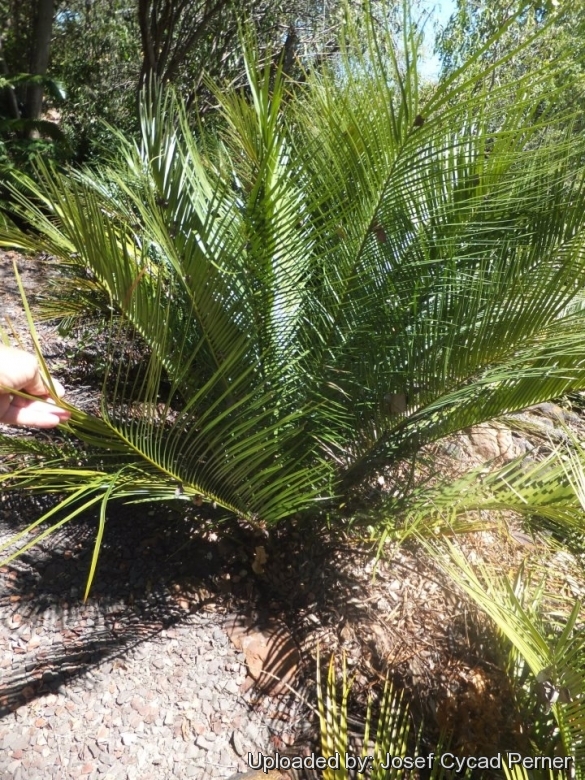
Origin and Habitat: Zamia inermisSN|31846]]SN|31846]] is endemic to central Veracruz, Mexico where it grows in the district of Actopan. Plants exist as two subpopulations in a small range of hills in the Rio Actopan drainage area, which is on the coastal side of Xalapa in central Veracruz. Z. inermis is an example of species with small range that is represented by few individuals within this range (Estimated area of occupancy of less than 10 Km2.). The populations are severely fragmented, and it has been estimated that this species include less than 300-500 extant mature individuals. Juvenile plants of the Zamia were not seen in the field.
Altitude range: 200-300 metres above sea level.
Habitat and Ecology: This species grows in deciduous tropical dry forest on steep slopes in low mountains in thin, dry, very poor volcanic soils with very little organic matter. Plants also occur on steep slopes. Z. inermis is known from only a single extant population that is severely threatened by too frequent fire, habitat destruction for agricultural purposes, crop spraying, soil erosion, over collection for ornamental purposes, and apparently eradication of its pollinator as evidenced by its very low fertility in habitat as opposed to its high fertility in cultivation in botanical gardens. Generation length 30 years. Zamia inermis is listed as ‘Critically Endangered’ on the IUCN Red List of Threatened Species, so that today, Zamia inermisSN|31846]]SN|31846]] is preserved primarily in botanical and private gardens.
Synonyms:
- Zamia inermis Vovides, J.D.Rees & Vázq.Torres
SPANISH (Español): Palmita
Description: Zamia inermis is a very rare species with attractive palm-like fronds, narrow leaflets and a elegant growth habit. It looks a lot like a Ceratozamia except its cones are unquestionably Zamia-like.
Distinguishing characteristics: Zamia inermisSN|31846]]SN|31846]] features numerous stiffly erect leaves forming a funnel pattern with smooth lime green, stiff, leaflets up to 15 cm long with margins entire. Microsporophyll facets are shallowly inclined, with numerous microsporangia (pollen-sacs) only on the abaxial (axis-facing) surface. The seeds that are brown at maturity unlike red or orange seeds of other Zamias.
Derivation of specific name. Its name, “inermis” is Latin for “unarmed”, to remark the absence of spines on the petiole and rachis of the leaf.
Stems: Subterranean and tuberous when young becoming aerial and up to 30 cm tall when mature, 10-25 cm in diameter, succulent, often dichotomously branched, but the stem usually lays over when it get too tall.
Cataphylls: The cataphylls (modified leaf, much reduced and thickened, serving to protect the apical meristem and produced in flushes preceding the emergence of cones or leaves) are triangular-lanceolate, 4-6 cm long and 1-1.5 cm wide.
Leaves: 10-25 in a crown, 30-100 cm long (in cultivation they can reach 120 cm), spineless and stiffly erect, forming an attractive spiraling funnel. Petiole 8-25 cm long, smooth (essentially free of spines), unlike many other Zamia species. Rachis smooth with 12-20 pairs of leaflets. Leaflets linear-lanceolate, attenuate basally, acute and pungent apically, strongly to extremely coriaceous, often adaxially concave, margins entire, the larger median ones 20-30 cm long, 1-1.5 cm wide.
Male cones: 1-6, tan to light brown, cylindrical to ovoid-cylindrical, acute apically, 8-18 cm long, 2.5-3 cm across. Peduncle 3-6 cm long, 1 cm scross.
Female cones: 1-3, tan to light brown, cylindrical, acute to blunt apically, tomentose when young becoming more or less glabrous at maturity, 12-20 cm long, 8-10 cm across. Peduncle 3-5 cm long, 2-2.5 cm across.
Seeds: Green when young, brown when mature, ovoid, 1.5-2 cm long, 1-1.5 diam.
Chromosome number: 2n = 16.
Bibliography: Major references and further lectures
1) The Cycad Pages: “Zamia inermis” Royal Botanic Gardens Sydney Written and maintained by Ken Hill 1998-2010 Maintained by Leonie Stanberg and Dennis Stevenson 2010-2012 <http://plantnet.rbgsyd.nsw.gov.au/cgi-bin/cycadpg?taxname=Zamia+inermis> Web. 18 Nov. 2014.
2) V.P. Singh “Gymnosperm (naked seeds plant) : structure and development” Sarup & Sons, 01 gen 2006
3) Vovides, A., Chemnick, J. & Gregory, T. 2010. Zamia inermis. The IUCN Red List of Threatened Species 2010. Downloaded on 12 September 2015.
4) David L. Hawksworth, Alan T. Bull “Plant Conservation and Biodiversity” Springer Science & Business Media, 18 September 2007
5) Osborne R. “The 1991-1992 world cycad census a. a proposed revsion of the threatened species status for cycads” In: Vorster P. (ed.) Proceedings of the Third International Conference on Cycad Biology. Cycad Society of South Africa 1995.
6) Jones, D.L. “Cycads of the World”. 2nd edn. Reed, Sydney. 2002.
7) Walters, T. and Osborne, R. “Cycad Classification Concepts and Recommendations”. CABI Publishing, Wallingford UK. 2004.
8) Whitelock, L.M. “The Cycads”. Timber Press, Portland, Oregon.2002.
9) Read, R.W. & Solt, M.L. “Bibliography of the living cycads. annotated.” Lyonia 2(4): 33-199.1986.
10) Dale Holton “GROWING Zamia inermis IN PALM BEACH COUNTY” <http://www.palmbeachpalmcycadsociety.com/cycads/documents/ZamiaInermis.pdf>
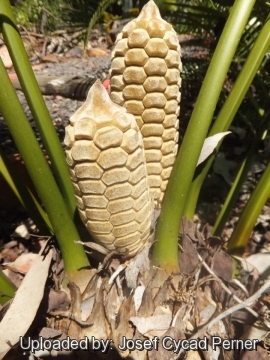
Female cones. Photo by: Josef Cycad Perner
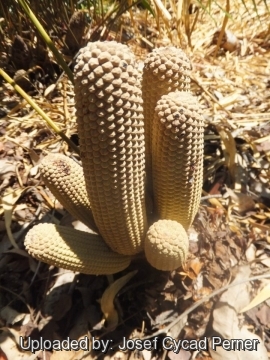
Male cones. Photo by: Josef Cycad Perner

Zamia inermis growing in Jurassic Cycad gardens. Female cones with viable seeds. Photo by: Josef Cycad Perner
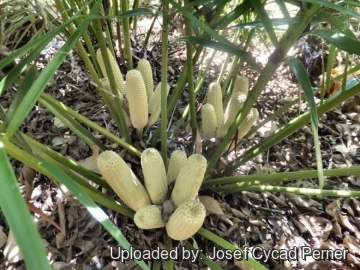
Male cones. Photo by: Josef Cycad Perner

Zamia inermis Photo by: Josef Cycad Perner
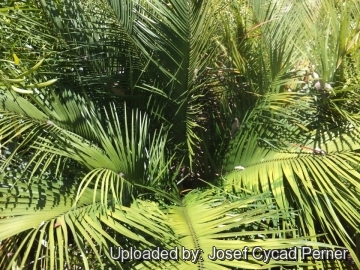
Zamia inermis Photo by: Josef Cycad Perner

Coning habit (female specimen) Photo by: Josef Cycad Perner
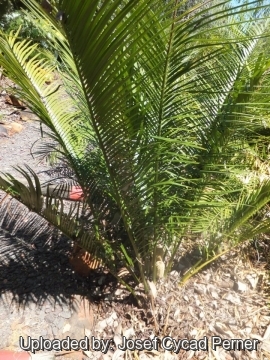
Coning habit (female specimen) Photo by: Josef Cycad Perner
Cultivation and Propagation: Zamia inermisSN|31846]]SN|31846]] is an extremely rare, relatively cold-tolerant beauty Zamia, tolerating dry periods. It is suited to tropical, subtropical and mild temperate regions which have a seasonally dry climate. It's one of the more cold hardy Zamias and a relatively fast grower. It likes well draining soil, and to not be overwatered when cold. It is extremely rare in cultivation and a highly prized cycad due to it's attractiveness as well as it's scarcity, and it is usually only available in speciality nurseries.
Growth rate: The seedlings start out somewhat slowly but speed up after a year or two, after that, under good conditions, it is a relatively fast grower. Because of its growth habit, fertilize only when terminal bud begins to swell, indicating the start of the annual growth cycle.
Exposure: It prefers bright light exposure but colour bleaches when in full sun; best with some protection from afternoon heat.
Soil: Needs a well drained spot, with deep soil, but will still thrive in less than ideal conditions.
Watering: These plants are very hardy and survive outdoors quite well without any irrigation, but enjoys regular waterings during the growing season. It must not be overwatered when cold and can tolerate some drought. It is a good species for drier areas like Southern California and Australia. It does not like wet tropical conditions.
Hardiness: They are not affected by winter cold spells and tolerates even short light freezes.
Maintenance: Minimal; removal of offsets if desired, removal of spent fronds. With each new leaf flush, the plants get a little taller. If the old leaves will be cut off every two years, the plants would stay shorter and be more attractive.
Pests and diseases: They don’t seem to get mealy bug or scale problems.
Use: Landscape as cultivated perennial in warm, coastal areas; House-plant or interior-scape, as container plant in cool areas.
Aerosol salt tolerance: These plants are resistant to salts.
Propagation: Seed. Hand pollination is very effective and produces about 70% or more viable seeds. The seeds are quite large and easily germinated.
| Your Actions | |
|---|---|
| Back to Zamia index | |
| Back to Zamiaceae index | |
 |
Back to Palms And Cycads Encyclopedia index |
Privacy stantement - Terms and conditions - How to cite - About us - Feedback - Donate


